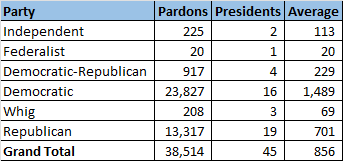Which president selected the most Supreme Court justices? It should come as no surprise that President Washington, being the first President, had the opportunity to select every justice on the original court. However, he only just surpassed another president. Let's see which presidents had the most judicial picks and those with the fewest.
There have been 116 justices, 17 of whom were Chief Justices. It is worth noting that the Court began with only 6 justices, before expanding to 7, 9, 10, and then shrinking to the current 9.
Four presidents did not select any justices. William Henry Harrison (9) died only 1 month into office. Zachary Taylor (12) died 16 months into office. The Congress changed the law in order to prevent Andrew Johnson (17) from having an opportunity to select a justice. Of note, the Court had 10 justices at the time and was slated to shrink to 7. With Johnson's departure, the Court was restored to 9 justices. Lastly, Jimmy Carter (39) didn't get to select a justice.
James Monroe (5), John Quincy Adams (6), John Tyler (10), Millard Fillmore (13), Franklin Pierce (14), James Buchanan (15), James Garfield (20), William McKinley (25), Calvin Coolidge (30), Gerald Ford (38), and Joe Biden (46) each selected one justice for the Court.
James Madison (4), Martin Van Buren (8), James K Polk (11), Rutherford B Hayes (19), Chester Arthur (21), JFK (35), LBJ (36), George HW Bush (41), Bill Clinton (42), George W Bush (43), and Barack Obama (44) each selected 2 new justices to the Court. However, George W Bush had the opportunity to select the 17th Chief Justice, John Roberts.
John Adams (2), Thomas Jefferson (3), Theodore Roosevelt (26), Woodrow Wilson (28), Herbert Hoover (31), and Donald Trump (45) selected three each. John Adams chose the longest-serving Chief Justice, John Marshall. Of note, Marshall was the 4th Chief Justice despite being chosen by only the 2nd president. Hoover selected Charles Evans Hughes for Chief Justice; Hughes had been an associate justice and was Chief Justice William Howard Taft's chosen successor.
Ulysses Grant (18), Grover Cleveland (22 & 24), Benjamin Harrison (23), Warren Harding (29), Harry Truman (33), Richard Nixon (37), and Ronald Regan (40) selected 4 justices for the Court. Most of these presidents also selected a new Chief Justice among the four picks. Grant chose Marrison Waite, Cleveland selected Melville Fuller, Harding installed former President William Howard Taft, Truman picked Fred Vinson, Nixon chose Warren Burger, and Reagan elevated William Rehnquist (Rehnquist had been one of Nixon's Associate Justice picks).
Abraham Lincoln (16) and Dwight Eisenhower (34) each had 5 Court picks. Lincoln chose Salmon Chase as the Chief Justice. Eisenhower selected Earl Warren to be Chief Justice.
Andrew Jackson (7) and William Howard Taft (27) selected 6 justices for the Court. Jackson replaced John Marshall with Roger Taney, the Chief Justice who is forever stained with the Dredd Scott decision. Taft, who would later be appointed Chief Justice, elevated Edward D White to be Chief Justice. He would replace White only a decade later.
Franklin Delano Roosevelt (32) chose 9 justices during his three terms as president. He elevated Harlan F Stone, an associate justice, to be the Chief Justice.
George Washington (1) selected 10 justices for the Court. Though there were only 6 justices at the time, the turnover was higher. In these early days, the Court didn't possess the prestige or power that it would gain in later years. For the first Chief Justice, he chose John Jay. Jay stayed in the position for 5 years before resigning to run for governor of New York (he won). Washington next chose John Rutledge. Rutledge had been rejected for associate justice by the Senate in 1789 and, when the Senate was again in session, he was rejected for Chief Justice as well. He served about 5 months as Chief Justice. Thus, Washington chose the 3rd Chief Justice, Oliver Ellsworth.



